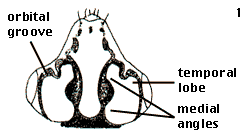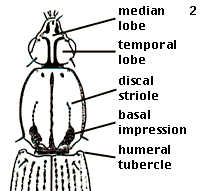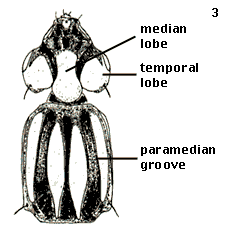1. Temporal lobe with two medial angles, separated by a semicircular emargination; orbital groove reaching occiput (Figure 1); elytron without humeral tubercle..........Rhysodes1'. Medial angle of temporal lobe single or absent; orbital groove short or absent; elytron with distinct humeral tubercle (Figure 2)..........................................2 Click on an image to view larger version & data in a new window
2(1). Medial margins of temporal lobes parallel, close to narrow, parallel-sided median lobe; basal impression of pronotum short, preceded by fine, curved discal striole which ends near middle of length of pronotum (Figure 2). ...........Kupeus2'. Medial margins of temporal lobes not straight nor paralleling sides of median lobe (Figure 3); most species with pronotum with complete paramedian grooves (in two species with anterior part of paramedian groove broken into row of large punctures.) .............................Kaveinga Click on an image to view larger version & data in a new window

Figures 1 and 3 modified from:
Bell, R. T. and J. R. Bell. 1979. Rhysodini of the World part II. Revisions of the smaller genera (Coleoptera: Carabidae or Rhysodidae). Quaestiones Entomologicae 15: 377-446.
Copyright © 1979, R. T. Bell and J. R. Bell.
Figure 2 modified from:
Bell, R. T. and J. R. Bell. 1978. Rhysodini of the World part I. A new classification of the tribe, and a synopsis of Omoglymmius subgenus Nitiglymmius, new subgenus (Coleoptera: Carabidae or Rhysodidae). Quaestiones Entomologicae 14: 43-88.
Copyright © 1978, R. T. Bell and J. R. Bell.




 Go to quick links
Go to quick search
Go to navigation for this section of the ToL site
Go to detailed links for the ToL site
Go to quick links
Go to quick search
Go to navigation for this section of the ToL site
Go to detailed links for the ToL site